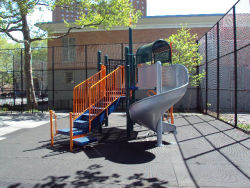Neptune Playground
Neptune Playground
This playground on West 12th Street takes its name from nearby Neptune Avenue. The avenue is one of Coney Island's three major east-west thoroughfares, the others also featuring aquatic names, Surf Avenue and Mermaid Avenue. Neptune Playground shares the distinction of being named for the god of the seas with Poseidon Playground, located on West 25th Street. Usually, the Roman god Neptune (or his Greek counterpart Poseidon) is represented with a three-pronged spear, the trident, which he used to smash rocks, calm the waves or stir up storms. According to Roman mythology, Neptune was the son of Saturn, and brother to Jupiter, king of the gods, and Pluto, god of the dead. Originally known as the god of springs and streams, Neptune came to be identified as the god of the seas. Much like the seas he ruled, the god was known for his moody, unpredictable and ever-changing behavior.
Almost a century before the Coney Island boardwalk opened along the Atlantic Ocean, Coney Island was already well on its way to becoming the nation’s most popular pleasure ground. In 1824, the Coney Island House, the first seaside resort in the area, opened and within a few decades it was playing host to a steadily increasing stream of visitors. After the Civil War (1861-1865), new railroad lines provided direct public transportation to a rapidly expanding list of attractions: restaurants, hotels, bathing pavilions, shops, amusement rides, racetracks, theatres, and as always, the beach and the ocean. At the turn of the century, amusement parks, Sea Lion Park, Steeplechase Park, Luna Park, and Dreamland, offered rides, concessions, and entertainment on a spectacular scale.
Once the BMT (Brooklyn-Manhattan Transit) subway line reached the area in 1920, the pleasures of Coney Island were just a five-cent ride away from the steaming city. Attendance on a hot summer day could reach as high as one million, causing extreme congestion on the beach. Making matters worse, private concessions (such as beachfront hotels, bathhouses, and cabarets) controlled large portions of the beach. Brooklyn Borough President Edward Riegelmann (1869-1941) was responsible for beautifying Coney Island and ensuring public access to the beach and shore. After the city secured title to property along the beachfront, the $3 million beach improvement and boardwalk construction was completed with great fanfare on May 15, 1923.
In 1966, this playground opened as Public School 90 Playground, jointly operated by Parks and the adjacent school. Nineteen years later, Parks named the lot Neptune Playground to honor the sea, the god, and the avenue. The park contains paddle tennis courts, handball courts, shuffleboard courts, basketball courts, volleyball courts, all-purpose asphalt play area, game tables, and benches. London Planetrees (Platanus x acerfolia) add some green to this small park. Today, Neptune Playground invokes the mythology of a past civilization while serving as a place of sport and activity for the people.
Check out your park's Vital Signs
Clean & Safe
Green & Resilient
Empowered & Engaged Users
Share your feedback or learn more about how this park is part of a
Vital Park System

